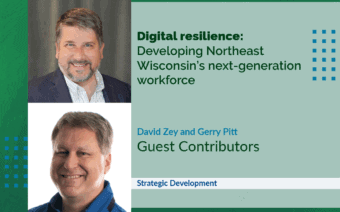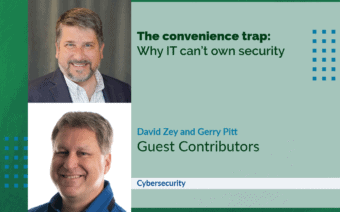
March 23, 2023
The ability to work from home has had a major hand in revolutionizing the modern workplace, while at the same time presenting unique cybersecurity challenges.
If remote work environments aren’t adequately secured, organizations potentially expose themselves to serious concerns, including leaked data, reputational harm, system outages and lost revenue.
Cybersecurity is essential whether in the office, working remotely or a hybrid of both.
Here are a few guidelines that can help ensure a secure online workspace.
Cybersecurity importance
Generally, in-office workers are protected by several layers of security infrastructure, such as firewalls and VPNs (virtual private networks) that provide a front line of protection against many forms of cyberattack.
However, when employees leave the office environment, new vulnerabilities tend to appear because many remote workers commonly bypass best practices relating to cybersecurity.
Home internet networks are commonly not as secure as enterprise networks – often, home users don’t keep up with antivirus and other software updates and may not use strong encryption to protect their routers.
Criminals know this and are always looking for ways to exploit these weaknesses.
Common risks
First, let’s identify some of the most common risks associated with working from home. Phishing attacks continue to be one of the most popular attack vectors among cybercriminals.?
These attacks involve tricking people into giving away sensitive information, such as login credentials or credit card numbers, and can be difficult to spot as they often appear to come from legitimate sources.
Malware is another widespread form of cybercrime in which cybercriminals try to “infect” a system with malicious software designed to steal data or damage a network.
Malware is often spread through email attachments and software downloads.
Weak passwords can be easy for cybercriminals to crack and could provide access to an organization’s email or data systems.
Another tactic of cybercriminals is to exploit unsecured Wi-Fi networks.
Those not secured with strong passwords or encryption are vulnerable to hacking, which could potentially allow access to all of the devices connected to them.
Finally, failing to update software can leave devices, routers and antivirus programs vulnerable to known security flaws.
The good news is, many of these security vulnerabilities can be mitigated by establishing clear-cut policies, comprehensive training and ongoing support from your organization’s IT department.
Creating safe environments
While not all-inclusive, here are eight strategies to create a safer remote work environment.
The first line of defense in protecting remote workers from cyber threats is to require the use of strong and unique passwords, as well as enabling multi-factor authentication (MFA) whenever possible.
A strong password consists of at least 12 characters and should include a mix of upper- and lower-case letters, numbers and special symbols.
Avoid using easy-to-guess information, such as birthdays, names or common words and phrases.
Consider using a password manager to help manage and generate complex passwords, and require workers to change passwords often and on a regular basis.
Multi-factor authentication adds an advanced layer of security to the login process by requiring an additional form of identity verification, typically a fingerprint, a text message code or a security token/key.
While not foolproof, using MFA can significantly reduce the risk of someone gaining unauthorized access to your organization’s data.
Next, strong remote work security depends on a secure home network.
Start by requiring employees to change the default login credentials for their router, including creating a unique password.
Enable WPA2 or WPA3 encryption – these are strong encryption protocols that make it difficult for cybercriminals to intercept internet traffic.
Giving the router’s SSID (service set identifier) a unique name and limiting network access to specific MAC (media access control) addresses can also help mitigate the risks associated with home networks.
Cybercriminals often exploit vulnerabilities in outdated software, so it is crucial to keep software up-to-date.
Software updates typically include security patches and bug fixes that address vulnerabilities hackers can exploit.
Ensure workers regularly update their operating system, antivirus and security software and any other applications used for work.
Consider employing a comprehensive security suite that includes endpoint detection and response (EDR) capabilities.
These tools monitor end-user devices across the network to detect suspicious activities and behavior.
It is also important to employ secure file-sharing tools.
File sharing is an essential part of remote work, but it can pose a significant security risk. Whether it’s messaging, video conferencing or secure file-sharing, the right tools can mitigate the risk of cybercriminals stealing your organization’s sensitive information.
Similarly, consider utilizing a VPN to encrypt internet connections and protect data from prying eyes.
A VPN creates a secure tunnel between devices and the internet, making it difficult for cybercriminals to intercept the data.
Finally, beware of phishing attacks – this common tactic of cybercriminals uses social engineering techniques to convince workers to take action, such as clicking a link or downloading a file.
Organizations should make it a priority to train workers to recognize the signs of phishing attacks and to report them to their IT department.
Workers should be wary of unsolicited messages and should verify the sender’s identity before responding or clicking on any links – never provide personal or sensitive information to someone you do not know or trust.
Phishing attacks also demonstrate the need to backup your data regularly.
Regular backups ensure your organization can recover data in case of a cyberattack.
Consider using cloud-based backup solutions or external hard drives to store your data.
The remote work environment presents unique cybersecurity risks.
Cybercriminals hope remote workers will bypass security guidelines that would allow criminals easy access to an organization’s systems and data.
Allowing people to work remotely can be beneficial for both employer and employee, as long as both follow best practices to secure their networks and protect sensitive information.
Detective Eric Edson is a 29-year veteran of the Sheboygan Police Department. In his role, Edson is responsible for investigating major crimes, which include financial crimes and fraud.
 Sugar Rush by Amanda brings fresh sweetness to Suamico
Sugar Rush by Amanda brings fresh sweetness to Suamico GB Children’s Museum to make room, ‘hay’ with new farm, agriculture exhibit
GB Children’s Museum to make room, ‘hay’ with new farm, agriculture exhibit








